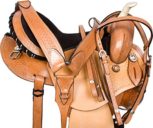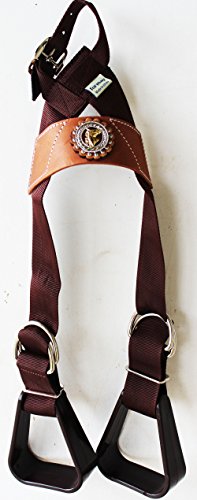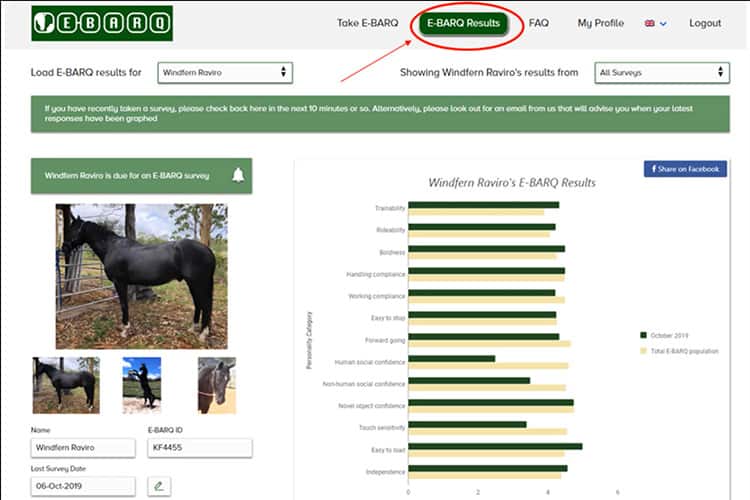How E-BARQ Works
The E-BARQ questionnaire currently consists of 97 multiple choice questions that owners can complete on a computer or a smartphone. It’s free and available in English, Spanish, and French, with more languages in development.
The survey is divided into two sections: 1) horse and owner demographics and 2) training, behavior, and management. Based on their responses, participants receive scores about their horses’ personality traits and behaviors, including trainability, rideability, boldness, handling compliance, working compliance, forward-going, human social confidence, novel object confidence, trailer loading, touch sensitivity, and more.
Fenner said E-BARQ is most effective if owners use it to monitor their horses over time: “By completing an E-BARQ survey every six months, you can see how changes in training and management are reflected in your horse’s behavior. It’s a tremendously valuable tool for trainers and owners.”
“We know behavior is a manifestation of a horse’s demographics, training, and management, and we appreciate there are some behaviors that will represent red flags,” said McGreevy. “That’s why as a longitudinal study (one designed to be repeated over time), E-BARQ will reveal some behavioral red flags we cannot ignore.”
Practical Applications
In addition to its benefits for individuals, E-BARQ offers a cohort feature that allows people and organizations to create groups for study and comparison. McGreevy and Fenner described groups that might benefit from this tool:
- Researchers can form E-BARQ groups for horses they’re investigating.
- With increasing emphasis on safety in the workplace, equine veterinarians can use the data to familiarize themselves with client horses and their behavior, as well as how they’re progressing through treatment. “Veterinarians faced with horses with undesirable behavior can encourage owners to participate in E-BARQ, share the behavior results, and take responsibility for the horse’s behavior by monitoring it,” said McGreevy.
- Behaviorists can monitor client horses’ behavior using a standardized tool and tailor treatment to the individual. This is groundbreaking, he said.
- Because temperament, rideability, and trainability are of paramount importance when breeding, said Fenner, breeders can use E-BARQ to showcase their horses or lines and optimize their breeding programs.
- Rescue organizations can monitor horses they’ve rehomed by requiring all adopters to complete regular six-month E-BARQ surveys. “They can monitor horses in a nonintrusive way while helping new owners with less experience better understand their horses’ behavior,” Fenner explained. “Or, imagine if every racehorse had E-BARQ results over its career—that would greatly assist in the rehoming process and better match horses with new owners.”
- Riding clubs can use the tool for organizational purposes. “For instance, if a riding club coach has an event coming up and the horses due to take part in the event have E-BARQ results, they’ll know which ones require extra attention or need to be handled differently,” she said.
- Trainers can showcase their methods by forming one or more E-BARQ groups for current students, graduates, social purposes, etc.
Overall, E-BARQ has promising training, management, and welfare implications for horses. “Horse welfare lags depressingly far behind other companion animals,” said Fenner. “It can be hard for us as riders and trainers to fail to see that our practices aren’t always good for the horse (e.g., noseband tightness). Horses are hardwired to hide pain and stress because in the wild that leaves them vulnerable to attack. It’s up to us to try harder with our horses because such distress will eventually affect their behavior.”









Comments
Comments are disabled for this post.